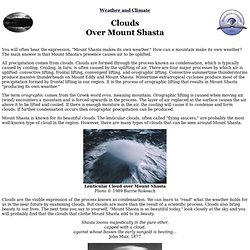

n02_sean-heavey.jpg (JPEG Image, 990×567 pixels) Rare-cloud-formations.jpg (JPEG Image, 580×449 pixels) Clouds Over Mount Shasta. You will often hear the expression, "Mount Shasta makes its own weather.

" How can a mountain make its own weather? The main answer is that Mount Shasta's presence causes air to be uplifted. All precipitation comes from clouds. Clouds are formed through the process known as condensation, which is typically caused by cooling. Cooling, in turn, is often caused by the uplifting of air. The term orographic comes from the Greek word oros, meaning mountain. Mount Shasta is known for its beautiful clouds. Lenticular Cloud over Mount Shasta Photo © 1989 Barrie Rokeach Clouds are the visible expression of the process known as condensation. Shasta looms majestically in the pure ether, capped with a cloud, against whose bosses the early sungold is beating...
Lenticular cloud over Mount Shasta, reflected in Siskiyou Lake Photo © 2001 Jane English Clouds are constantly changing shape and so it is sometimes difficult to categorize them. Cirrus Cirrocumulus. Clouds That Look Like...Boobs. Photo by Jorn Olsen The shapes one sees in cloud formations can be as revealing as an inkblot test which is why there's something undeniably Freudian about calling these clouds mammatus clouds or "breast clouds.

" Forming under the main body of other cloud types, mammatus clouds are pockets of air and water caught in another storm's down draught. Mammatus are often called "supplementary clouds" as they are not clouds in their own right. They are usually paired with cumulonimbus thunderclouds and can indicate severe storms and tornados. Cumulonimbus clouds contain the ice crystals which frequently produce hail stones and torrential rain. Here in the United States, mammatus clouds are often seen during warmer months in the midwest or back east. Mammatus may be smooth or lumpy and may be opaque or semi-transparent.
Like this article? Photo by Jorn Olsen Photo via Wikimedia. 10 Rare Cloud Formations. Our World This is a list of what I believe to be the top 10 rarest cloud formations.

And a brief description of each. No particular order in how ‘rare’ they are though. 1. Nacreous Clouds These rare clouds, sometimes called mother-of-pearl clouds, are 15 – 25km (9 -16 miles) high in the stratosphere and well above tropospheric clouds. Nacreous clouds shine brightly in high altitude sunlight up to two hours after ground level sunset or before dawn. 2. Mammatus are pouch-like cloud structures and a rare example of clouds in sinking air. 3. Also known as jellyfish clouds due to their jellyfish-like appearance. Cloudtypes1.jpg (JPEG Image, 700×468 pixels)